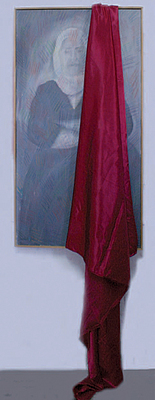
Asad Azi
Asad Azi earned his B.A. in Art and Philosophy from Haifa University (1976 to 1980) and his Masters in Art History from Tel Aviv University (1980 to 1988). He has been exhibiting work since 1982. Selected solo exhibitions include: the Israel Museum (1987), Artifact Gallery (Tel Aviv, 1988 and 1992), The Municipal Cultural Center in Nazareth (1991), the Nelly Aman Gallery (Tel Aviv, 1993 and 2007), Haifa University Art Gallery (1994), Ashdod Museum (1994), the Khalil Sakakini Art Center (Ramallah, 1998) and Um el-Fahem Gallery (2005). Azi’s work has also been featured in group exhibitions at the Museum of Modern Art (Haifa, 1986), the 42nd Venice Biennial (1986), The Cooper Union (New York, 1988), al-Wasiti Art Center (Jerusalem, 1995), the Cass Museum in (Miami, 1995), the Grey Art Gallery (New York, 1997), Okashi Museum (Akka, 1998) and 100 Years exhibition at the Museum of Modern Art (Milan, 2006). Azi currently teaches art at several insitutions in Israel, he lives in Jaffa.
This is an oil painting is a portrait of my mother, her ghostly presence. I painted it thirty years ago, and I have carried it with me every time I moved from one rented house to the other in my voluntary exile in Jaffa. Thus has the painting accompanied me; with the passing of days, it overpowered me, claiming a space for itself above my bed. I sleep as it gazes at me, tender and caring; I wake up as it gazes sombre and scolding.
I named her Mona Lisa of the Galilee. It became my refuge, my respite, we have never parted, and distance is never far apart.
I talk to her about myself, she listens; I complain, she emboldens my spirit; I have indulged wildly within her sight, never has she betrayed my secrets.
Her mothering has ordered the cadence of my life, she has determined the realm of my movement and choices; sometimes she has intimated herself between my companions and I, but in the end she was the one to stay, while they left.
An entire lifetime we faught over “Me”; for a lifetime longer than wished for, she has won and I have complied and obeyed.
In the beginning, I threw a piece of cloth to cover her, so she would not see me and I would not see her.
Today, I dispatch her to beyond the sea, were I to forget her, perhaps she too might pretend to forget me as well.
More than this, I cannot reveal.
How difficult was it to agree to part, albeit momentarily, with the object you are lending to the exhibition? Did you have reservations? Was the process liberating or anxiety-causing?
It still hangs over my bed as I speak with you, I am worried about assurances that it will return after I remove it. It will leave a hallow emptiness. The parting process is difficult, not liberating rather is anxiety causing. I feel the painting holds me in the air. It is inspired from the Madonna and Jesus, her son. Mother and child. You see, my father died when I was five, I barely knew him. The painting is one work in a very long project. Everyone that has seen it has had a strong reaction, it has a particular power. If it is lost, a great, great deal will be lost.
Does the exhibition of the object and exposition of the narrative surrounding it present closure to the traumatic story it encasses or represent?
In principle paintings or art works don’t need to be accompanied by texts to explain them. In this case however, there is also representation in the accompanying text. Adjoined to this powerful work, the text will make the painting seem more obscure. The sentence, “no able talk”, flashing on the painting does not contain an indication as to who is saying it. It is remains like an open question.
Does the object/text/image represent something (a meaning, a tension, an emotion, a fact, an experience) that other works –those parted with– do not represent? Or represent incompletely?
I see the work as an icon, and you know icons are a visual compensation for something that’s totally lost. In my own imagination and specifically regarding the flashing sentence “no able talk”, the work is all about loss.
In being physically present and in your possession, the object is evidence of a non-loss, and yet when the meanings and representation are deconstructed, it turns out to either represents a loss, or throw back to one. How central is the burden of loss to your creative process?
There is not a single day that goes by when I don’t draw, this practice is intimately bound to an existential anxiety to prove my existence. This motivation is, I believe, shared, by all Palestinians, it is our drive to survive. Affirm our being.
To what extent do you feel your art practice writes history? Another version of history?
I live in Jaffa, exiled in my own county, isolated. I don’t connect to people through my artistic practice. Palestinians, in my opinion, have no choice but to live every day, every hour of their lives, totally, to life’s fullest, to compensate for the meaninglessness of the quotidian of all the people in the world. It is almost as if a beast had devoured our side, and we have become continuously on guard, as well as creative, prolific. Palestinians cannot live with pretence, or as if nothing happened. I have no inhibition against drawing my childhood and taboos. My work would be worthless if it did not challenge the lethargy [or fossilization] in which the Arab world seems to have sunk.
